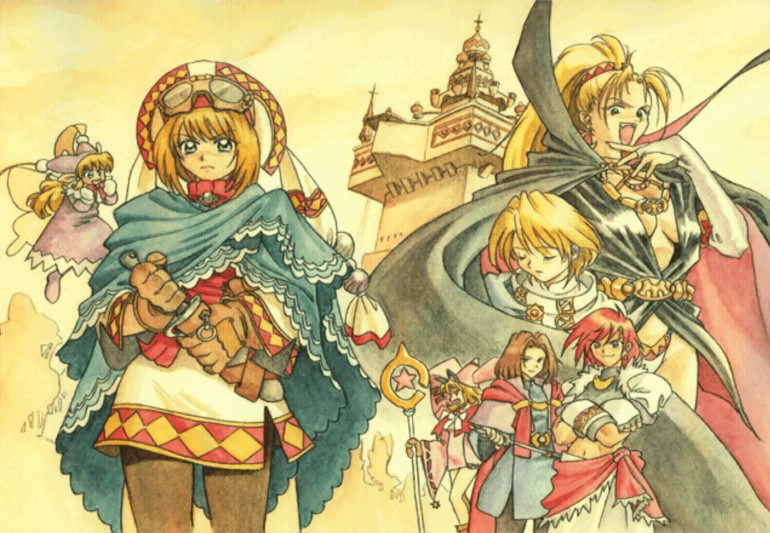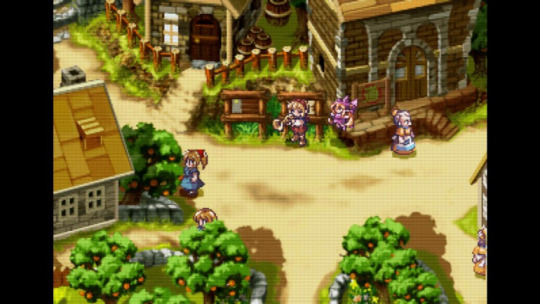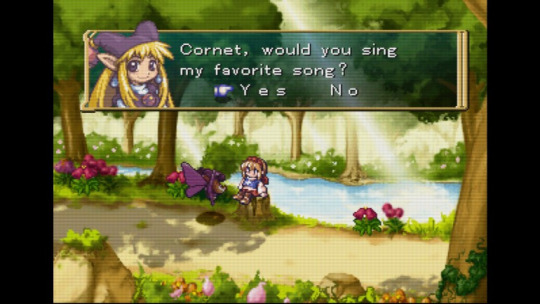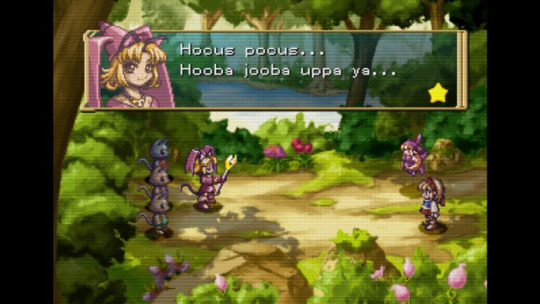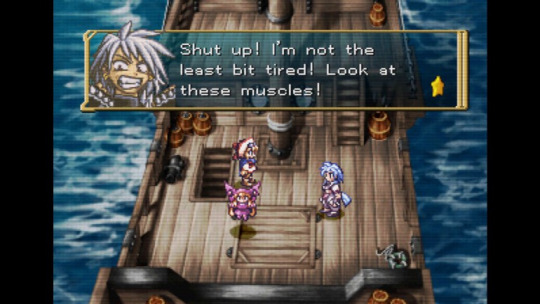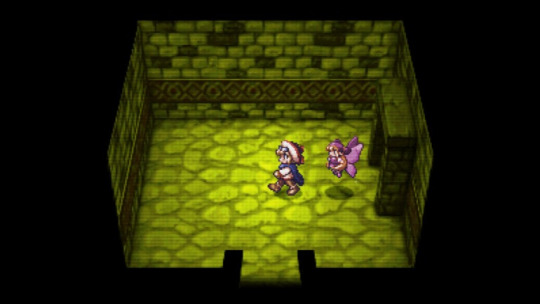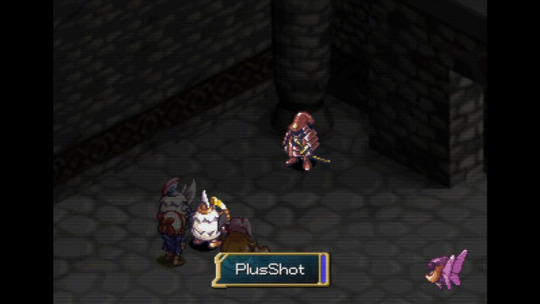Amid the games offered in the Nis America’s rerelease series “Prinny Presents NIS Classics”, Rhapsody: A Musical Adventure doesn’t fit as well as the others featured. While a good amount of them offer complex combat and a huge amount of potential playtime, Rhapsody is rather short and… probably one of the easiest SRPGs ever made.
The only way you could guess why it got chosen to be a part of these rereleases is the fact that it is one of the first two tactical RPGs developed by Nippon Ichi Software before they hit it big with Disgaea, which changed the company’s destiny forever. This makes a lot of sense knowing that the game that accompanies it in its PC and Switch rerelease is La Pucelle, which is the only other SRPG title they made before the first Disgaea. Just by taking a glance, you can already see a big difference in how they chose to approach both games’ remaster. While La Pucelle received many quality of life changes, Rhapsody went relatively unchanged (besides now offering a beautiful CRT mode).
The reason for this is that the original 1998 Atlus localization for Rhapsody was already uncommonly complete for the time. It had options for both Japanese and English voice acting, extra unlockable illustrations, and the game was already easy enough that it didn’t warrant any balance changes for the west. Unfortunately, it did not sell well enough for its two sequels to also be localized, which is a shame because both seem incredible.
Note: Even though there are no currently available in-game translations for Rhapsody’s sequels, you can find fully translated scripts for Little Princess: Marl Ōkoku no Ningyō Hime 2 and Tenshi no Present: Marl Ōkoku Monogatari here and _here, respectively.
Even the game’s songs were completely rerecorded with English voices (though they are the only parts with any amount of voiceover at all). There lies the most intriguing part of Rhapsody. It’s a whole damn musical. Like, there are six unique songs coupled with some special versions of the main theme. Every song is sung in a perfectly (and sometimes beautifully) acceptable manner by the American cast. I was expecting the next song to arrive at every step I took while playing. Fortunately, the best songs here are sung by Cornet, and there are a lot of them because, well, she’s the protagonist and all.
It’s really impressive how unique Rhapsody ends up being because of its stylistic choices because deep down, it’s a pretty by-the-numbers JRPG. Enough so that it feels weird that they bothered making this a tactics game at all considering how little it matters for the game aside from making battles last longer since you have to position your party members on range to hit an enemy before attacking. On a normal RPG, it would take one turn to hit your opponent. Here, most party members take two to get their first hit in.
The easygoing difficulty on offer by Rhapsody is enough to get hardcore fans of the genre to completely ignore its existence, which makes sense if you’re only on the lookout for a challenge and nothing more. But I’d argue that Rhapsody is much more interesting when seen through other lenses.
For starters, it works perfectly as a potential first game for people who have never touched a game in their lives. Even some simple 3D titles considered to be good entry points by game fans end up being a headache for beginners, but Rhapsody here speaks for itself. If you ignore some repetitive dungeon layouts and one or two innocuous dialogues you need to trigger to advance the story, none of the mechanics here would seem confusing for a complete newbie.
This is understandable because the actual target demographic for this game is kids, even though it can handle serious topics in some story beats. Rhapsody is structured in a similar manner to a Disney Princess movie (only with the roles reversed), which is a big compliment coming from someone like me, who absolutely adores Cinderella and the likes of it. Cornet is a daydreaming girl that can talk to and understand any puppet/doll. Now that I mentioned it, she can even transform them into party members by playing her favorite melody on her cornet. They’re not only important to the narrative, but also to the combat, where they work kinda like they do in Dragon Quest V.
However, the only puppet that can’t fight is Kururu, Cornet’s favorite that has been with her since her mom was murdered during a mysterious war that was going on at the time. Kururu is present throughout the whole game and acts as a mentor figure that forces Cornet to make difficult decisions (and sometimes makes some for her, which often backfires). The first song that features any vocals (excluding the intro one) only gets to play because of Kururu, when she asks Cornet to play “her favorite song”. Now the same song she loves playing on her cornet gets to be interpreted vocally for the first time in the game. It’s called Let’s Go On and it regularly gets different verses when it gets reprised in later sections of the plot, from which it adapts its tone to fit.
The cutesy animations that Cornet and the other characters make when they sing their tracks are immensely adorable and help them be more memorable than they would otherwise. They’re essential little touches that serve to not make the songs seem like they completely halt the game’s narrative. Oh, besides, they also advance both the story and the characters’ individual arcs!
This makes me a little bummed out since there are one or two songs that are not only way too short, but also don’t help out that much in developing the story, particularly the ones placed in the middle of the adventure. Nevertheless, I’d say that the way they incorporated the musical elements into the rest of the game was made with care, and forms an irreplaceable piece of the emotional impact Rhapsody’s story seeks to usher in.
Cornet loves singing as much as she dreams about being rescued by the beautiful Prince Ferdinand, who she’s completely obsessed with. Her dream kinda comes true when he randomly shows up to rescue her from a dragon conjured by Myao, an easily irritable witch that controls the population of anthropomorphic cats that live in the Wonder Woods. Unfortunately, Cornet is just as human as any of us and completely freezes when confronted by her crush. While Ferdinand tries to talk to the anxiety-ridden static girl, she can’t as much as move a single pixel.
In the end, she ends up not even being able to share her first name with the prince, which worries her because how lucky would she have to be to find Ferdinand again? He lives in a castle inside the big city of Mothergreen while Cornet lives in the rural Orange Village. He’s royalty, and she’s a plebeian. So of course she goes out to find him anyway.
Let’s skip a tiny bit of the important character stuff established early into the first hours of the adventure because I really want you to actually play Rhapsody instead of only reading my article about it. Amid an annual (and official!) contest in which girls take part to gather the prince’s attention, Cornet manages to reconnect, even if negatively, with her spoiled and fashionable childhood friend Etoile and ends up tying with her at the top spot of the contest.
The only problem is that Myao remembered how embarrassed Ferdinand made her feel the day he defeated her, so she ran a dragon through the castle walls and, accompanied by her friends Gao and Crowdia, let her mentor Marjorly steal the prince for herself. Being as clumsy as she is, Marjorly ends up transforming the poor dude into a statue by accident instead of using the love spell she intended to.
That’s when the game starts to open up. Cornet gains a new stylish outfit, the famous elemental stones are introduced for you to hunt down, etc. You know, the classic structure of a run-of-the-mill JRPG of that time. I’m not going to lie here, some narrative concepts Rhapsody tries to explore are not that interesting, but… I’d be a complete liar if I omitted how much the characters and their individual arcs are used to transform what could be a boring story into an actually engaging one.
First off, the dynamic between Cornet and Etoile represents a good example of this exact thing. They’re always fighting and the person who most often starts throwing insults around is Etoile. But you can see in the way in which they interact (and confirm with later story events) that in reality, they are just inseparable friends. Etoile is also searching for Ferdinand, but instead of taking Cornet’s puppet-based heroic approach, she hires bodyguards to protect her with guns. A bunch of them. She even gets some herself. Yeah, this seemingly medieval RPG introduces firearms out of the blue. How cool is that?
Even as rivals, they can’t help but give each other a hand to move on. This is made clear right at the beginning when Etoile and Cornet start to fight to see who says sorry first to the close person which they emotionally hurt during the contest’s events, and it gets even deeper as their relationship develops while you’re on the search for the elemental stones.
Each of the stones is located in a remote place that has its own history attached to the artifact. This part of the game focuses on telling five different tales independent from the main story arc with a surprisingly high variety in tone and unfortunately, quality as well. Of course, it’d be weird to expect complete consistency between the five stories, but some of them don’t even look like they came from this game because of how tonally off they are.
The search for the Waterstone on the pirate boat is a good example of this. You meet pirates that have been victims of a shipwreck that killed a big chunk of the crew in the past. The victims’ dad and best friend are still on the high ranks of the crew, and they both blame themselves for the dude’s death. This part doesn’t offer a traditional dungeon but instead the boat you can explore, which is pretty tiny. Together, the three pirates involved in this plot have about 30 lines of dialogue, and that’s it.
This doesn’t go for all of the elemental stone quests though. Some of them end up in tragedy, and almost all of them require Cornet to make a morally questionable sacrifice in order to get a stone. I’m not going to go into much detail so I don’t spoil anything, but what I’ll say is that the game presents very abrupt and heavy scenarios on occasion, which is pretty cool. These end up making up the most interesting pieces of the middle section of Rhapsody, which needs to have a bigger emotional heft to function properly because of its problematic dungeons.
Funnily enough, I haven’t been that satisfied with the dungeons in most recent RPGs I’ve played, even though I have a bigger tolerance for grind and repetition than most people. Games like Crystar and Cruel King and the Great Hero were way too repetitive for my thumbs to even enjoy playing them, and unfortunately, I can say some of the same things for Rhapsody’s dungeons. The common link between these games’ dungeon crawling is that they only exist in order to space out combat encounters instead of requiring thorough exploration.
In Rhapsody, there are two types of dungeons: caves and towers. If you’ve seen either one of them, you’ve seen them all, because the only difference you can spot is an occasional color palette swap. They’re just collections of square rooms with paths — Zelda style — but with a whole bunch of nothing inside. They only lead to new floors, maybe some items and extra collectibles, and eventually a boss. Navigating the dungeons isn’t a difficult task since the combat never drains your resources, but I still lost a couple (maybe more) hours just trying to get my bearings because of how repetitive they feel. Don’t feel bad for looking up a dungeon map online if you’re getting bored.
The dungeons do take a considerable amount of the overall playtime, but that sure wasn’t enough to ruin my experience, not even close. What matters here is that outside of them and during the dialogue and beautifully drawn areas, things work out much more smoothly. Cornet manages to create a genuinely deep connection with the rest of the main cast because she’s constantly humanized. Her decisions are what make her strong and Kururu, Etoile and her grandpa are all there to reinforce exactly this.
It would be cool if the puppets spoke a little more during the story, but at least they gain an interesting bit of focus on the village side quests (and the worldbuilding). They’re kinda hard to find for yourself, so I recommend a guide if you wanna play ’em all. Besides that, they let you in on more solid context to what is one of the biggest emotional pillars present in Rhapsody’s world, which I’ll touch on now without getting into spoilers.
Rhapsody has a few plot twists just like any ambitious RPG. One of them made me tear up. This is the first time this happened to me in a game where the pace is controlled by the player. In a cinematic title like, say, Life is Strange, it’s easy to get emotional in a scene cautiously acted and paced to gather this response. I know this because it happened to me a few times (lol). Now, in a JRPG with no voices (at least when no one’s singing) with the dialogue speed controlled completely by the player, this caught me completely off guard.
What happens here is a beautiful role subversion that ends up recontextualizing the whole game and that made me realize how important it was for Cornet’s arc as a whole after reevaluating the couple hundred screenshots I took while playing. Since I don’t wanna spoil anything, I’ll leave it at that.
The last thing I wanna say (exactly after saying I’ll leave it at that, no less) is that this twist ties the songs and the ambiance together both thematically and practically, so much so that it ends up stealing a bit of the climax’s shine. It was the perfect last screw to drill in my head how special Rhapsody really is.
Besides its narrative, the game also shows its personality in many other areas, and constantly. For starters, it pays out really well to poke around random objects trying to find any extra dialogue or a hidden potion or to, even more so than in other JRPGS.
Potions and extra items don’t matter in the grand scheme of things considering how easy the game is, but sometimes you get some cute illustrations or even a little jingle that sings “Nippon Ichi Software”. Yes, I checked: it said “Atlus USA” in the original version. The change may have happened in the DS version (though I’m not sure) and then reused in this current port.
It’s great to have these occasional jokes and extra dialogue that you get while just interacting with samey-looking things in different-looking places. Usually, Cornet will comment on how strange it is to see a repeated asset or even infer some difference she can see even though the graphics don’t let us see it as well. Some people have a bunch of problems with how Atlus localized their titles at the time and I do agree with some of those arguments, but I can’t see how this would have negatively impacted Rhapsody in specific. Honestly, the dialogue here sounds more current than many other drab modern localizations made by other companies.
Besides that, the visuals themselves are also refreshing. The character portraits show a lot of personality, and there are so many of them that I swear some of them are just used once or twice throughout the whole game. Lastly, we have the surprisingly good fashion sense present, which is mainly represented by Cornet, who completely changes her fit as soon as she leaves to search for her prince. Remember, those are whole animations that had to be reworked for this to be implemented, and that’s something only a game made with love can achieve.
Rhapsody: A Musical Adventure was an unforgettable experience, even though the idea didn’t reach its full potential in this title. I really hope NISA is interested in localizing the sequels, but I know that’s not an easy task. Just for some perspective, one of the fan-translated scripts I linked earlier, the one for Tenshi no Present: Marl Oukoku Monogatari, has 42.000 words in total, and at least up until the sections I read there wasn’t any optional NPC dialogue in there… Translating and implementing the translation into the game isn’t an easy task, but I still think it’ll be worth it if this Rhapsody rerelease does well.
In order to make a special JRPG, a perfect combat system or impeccable dungeons are rarely needed. It’s honestly easier to achieve this using the genre’s biggest strengths, which are its potential scale and ability to use unique storytelling methods to enhance a narrative. Rhapsody takes advantage of both while adding its own secret sauce, the musicals. In fact, I think tender is a good word for summing up the experience.
May the world turn into a more tender place, and may Rhapsody then provide the tenderness you need.
bye!
